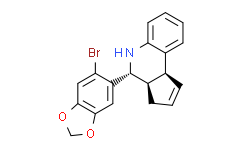| Cas No.: | 1161002-05-6 |
| Chemical Name: | (3aS*,4R*,9bR*)-4-(6-Bromo-1,3-benzodioxol-5-yl)-3a,4,5,9b-3H-cyclopenta[c]quinoline |
| Synonyms: | (3aS*,4R*,9bR*)-4-(6-Bromo-1,3-benzodioxol-5-yl)-3a,4,5,9b-3H-cyclopenta[c]quinoline;(3aS,4R,9bR)-4-(6-Bromo-1,3-benzodioxol-5-yl)-3a,4,5,9b-tetrahydro-3H-cyclopenta[c]quinoline;(3aR,4R,9bS)-4-(6-bromo-1,3-benzodioxol-5-yl)-3a,4,5,9b-tetrahydro-3H-cyclopenta[c]quinoline;G-15;(3aS,4R,9bR)-4-(6-Bromo-1,3-benzodioxol-5-yl)-3a,4,5,9b-tetrahydro-3H-cyclopenta[c]quinoline (G-15);G15 |
| SMILES: | C1=CC=C2C(=C1)[C@@H]3C=CC[C@@H]3[C@H](C4=CC5=C(C=C4Br)OCO5)N2 |
| Formula: | C19H16NO2Br |
| M.Wt: | 370.23984 |
| Purity: | >98% |
| Sotrage: | 2 years -20°C Powder, 2 weeks 4°C in DMSO, 6 months -80°C in DMSO |
| Description: | G15 is a high affinity and selective G-protein-coupled estrogen receptor (GPER) antagonist with a Ki of 20 nM[1][2]. |
| In Vivo: | G15 (1.46 mg/kg; i.h.; twice a week for 14 weeks) decreases the number of tumor nodules and tumor index increased by the E2 or G1 group in urethane-induced adenocarcinoma mice[1]. Animal Model: Four-week-old female Kunming mice (Urethane-induced adenocarcinoma)[1] Dosage: 1.46 mg/kg (combination with E2, 0.09 mg/kg and fulvestrant (Ful), 2.4 mg/kg) Administration: Subcutaneous injection; twice a week for 14 weeks Result: The number of tumor nodules decreased in the E2+Ful+G15 group. |
| In Vitro: | G15 (0.1-10 μM; 2 days) inhibits GPER-mediated proliferation stimulated by 17β-estradiol (E2) in A549 and H1793 cell lines[1]. G15 (1 μM; 48 hours) inhibits the response of GPER stimulated by E2 and G1 in A549 and H1793 cell lines[1]. Cell Proliferation Assay[1] Cell Line: A549, H1793 cell lines Concentration: 0.1, 1, 10 μM (combination with 10 nM E2) Incubation Time: 2 days Result: Inhibited GPER-mediated proliferation stimulated by E2. Western Blot Analysis[1] Cell Line: A549, H1793 cell lines Concentration: 1 μM (combination with 10 nM E2 and 10 nM G1) Incubation Time: 48 hours Result: Inhibited the response of GPER stimulated by E2 and G1. |
| References: | [1]. Liu C, et al. G-Protein-Coupled Estrogen Receptor Antagonist G15 Decreases Estrogen-Induced Development of Non-Small Cell Lung Cancer. Oncol Res. 2019 Feb 21;27(3):283-292 [2]. Girgert R, et al. Estrogen Signaling in ERα-Negative Breast Cancer: ERβ and GPER. Front Endocrinol (Lausanne). 2019 Jan 9;9:781. |

 DC Chemicals' products qualify for U.S. tariff exemptions. We guarantee no price increases due to customs duties and maintain stable supply, continuing to deliver reliable research solutions to our American clients.
DC Chemicals' products qualify for U.S. tariff exemptions. We guarantee no price increases due to customs duties and maintain stable supply, continuing to deliver reliable research solutions to our American clients.





















